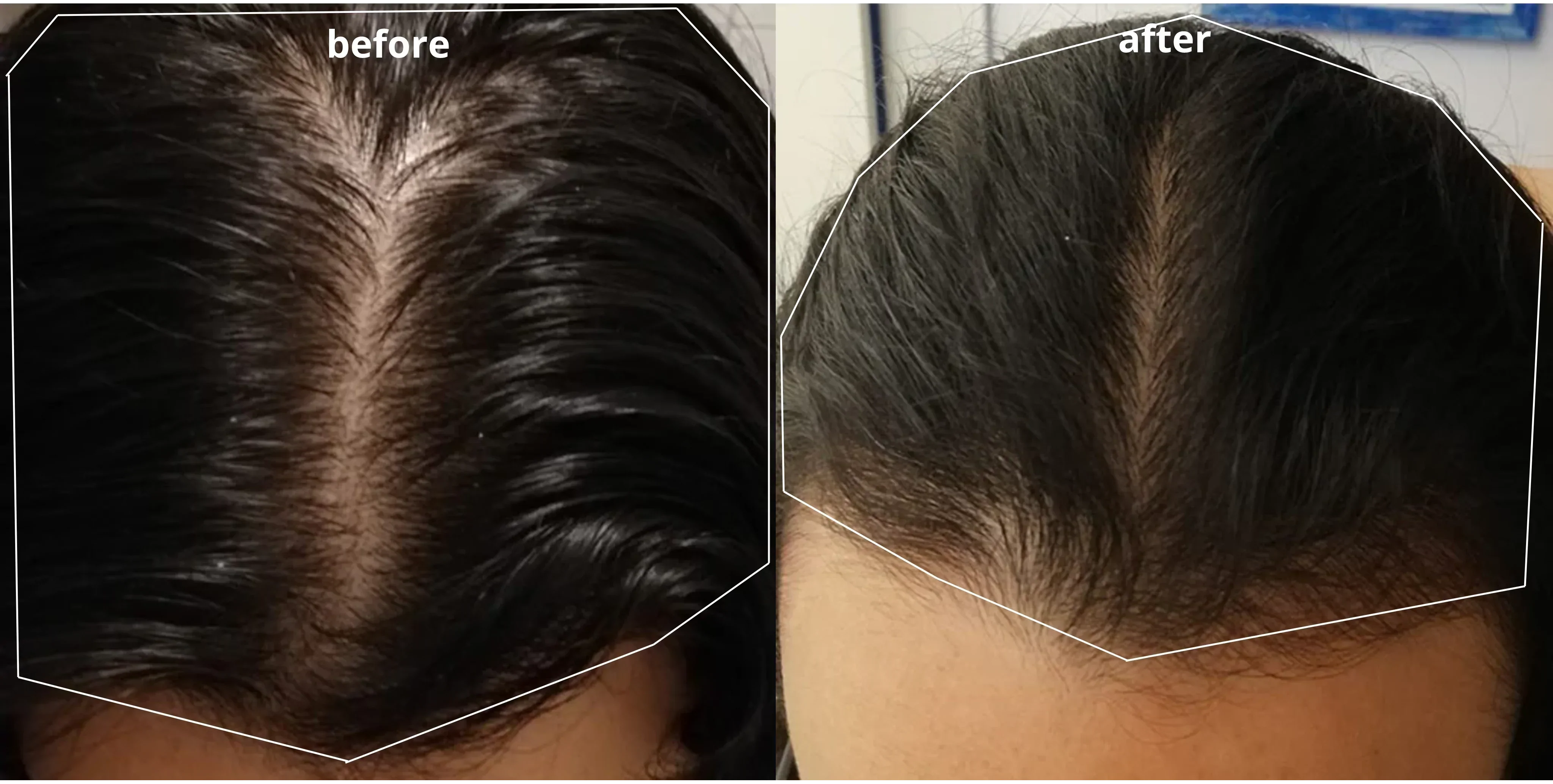Hair loss is a common problem that affects people of all ages and genders. It can be caused by various factors such as genetics, aging, stress, and poor nutrition.
For years, minoxidil has been the go-to treatment for hair loss, but in recent years, a new player has emerged in the market - Redensyl.
Both are popular and effective treatments, but which one is better?
In this blog post, we will compare Redensyl vs. Minoxidil and explore their differences, benefits, and drawbacks to help you decide which is best for your hair loss needs.
So, let's dive in and discover which treatment reigns supreme!
Table of content
What is Redensyl?

Redensyl is a patented hair care ingredient that stimulates hair growth and increases hair density. It is a blend of various plant-based compounds, such as green tea extract, zinc, and glycine, which work together to target hair stem cells and promote hair growth.
Redensyl is often used in hair care products such as shampoos and serums and is said to be a natural and non-invasive alternative to traditional hair loss treatments.
How does Redensyl work?
Redensyl is a hair growth ingredient that stimulates hair growth and reduces hair loss by targeting hair follicle stem cells. It consists of plant-derived molecules, DHQG and EGCG2, which activate stem cell division, prolong the hair growth phase, and reduce inflammation associated with hair loss.
Redensyl's blend of plant-based compounds, including DHQG, EGCG2, glycine, and zinc, work together to activate the Wnt/β-catenin signalling pathway, improve hair follicle anchoring, and maintain healthy hair.
Clinical studies have shown Redensyl to effectively improve hair density and reduce hair loss, making it a popular choice in hair care products.
Benefits of Redensyl for hair
Redensyl has several benefits for hair, which include:
- Targeting hair follicle stem cells and promoting their activation, leading to increased hair growth and density.
- Clinical studies demonstrate a 28% increase in hair density, making it an effective solution for thinning hair.
- Enhancing the anchoring of hair follicles to the scalp, reducing hair fall and breakage.
- Offering a natural and non-invasive alternative to traditional hair loss treatments, such as minoxidil or hair transplantation.
- Providing anti-inflammatory properties that soothe the scalp and reduce inflammation contributing to hair loss.
- Easy incorporation into hair care products like shampoos and serums makes it a convenient and hassle-free option for promoting hair growth and improving hair density.
Overall, Redensyl is a promising ingredient for those looking to improve the health and appearance of their hair, particularly for those with thinning hair or hair loss concerns.
Side effects of Redensyl
Some possible side effects of Redensyl may include:
- Scalp irritation: Some people may experience mild scalp irritation, redness, or itching when using Redensyl-containing products.
- Allergic reactions: In rare cases, some individuals may be allergic to one or more of the ingredients in Redensyl and may experience an allergic reaction.
- Hair shedding: Some people may experience increased hair shedding during the first few weeks of using Redensyl-containing products. This is a normal part of the hair growth cycle and should subside as new hair growth occurs.
It's important to note that these side effects are relatively rare, and most people can use Redensyl-containing products without experiencing any adverse effects.
However, if you do experience any of these side effects, it's important to discontinue the use of the product and speak with a healthcare professional or dermatologist.
As your leading source for hair health information over the past 4 years, we never compromise on accuracy. When it comes to your health, you deserve information you can truly rely on - and earning your trust is our top priority.
Here's how Scandinavian Biolabs ensures every piece of content meets the highest standards of accuracy and integrity:
- Credentialed Experts: Our reviewers are actively practicing doctors and medical researchers
- Stringent Reviews: Content undergoes rigorous editing by subject specialists and review by a practicing doctor.
- Evidence-Based: We rely on well-established research from trusted scientific sources like peer-reviewed journals and health authorities.
- Full Transparency: Our editorial standards, writer credentials, reviewer credentials, correction process, and funding are all publicly documented.
- Independent Voice: While we do promote products, we operate in a vacuum to business operations. Our main goal is just an unwavering commitment to providing medically-sound guidance.
You can count on Scandinavian Biolabs to consistently deliver the trustworthy health information you deserve. Read our Editorial Standards.
What is Minoxidil?

Minoxidil is a topical medication used to treat hair loss. Originally developed for high blood pressure treatment, it was later discovered to promote hair growth.
Minoxidil works by increasing blood flow to the hair follicles, which can stimulate hair growth. It is available as over-the-counter and in prescription strength formulations and is considered a safe and effective treatment for hair loss in both men and women.
How does Minoxidil work?
Minoxidil is an FDA-approved medication for treating hair loss and promoting hair regrowth. It works by increasing blood flow to hair follicles, providing essential nutrients and oxygen, and prolonging the growth phase of the hair cycle. This results in thicker, healthier hair strands.
Minoxidil is commonly available in 2% and 5% solutions and is effective for androgenetic alopecia and other hair loss conditions.
Consistent use is required to maintain benefits, as discontinuing treatment may reverse progress. Minoxidil promotes cell division and DNA synthesis, leading to hair growth, but initial shedding may occur before new strands emerge.
Patience and persistence are necessary, as results typically appear after five months of consistent application.
Benefits of Minoxidil for hair
Minoxidil has several benefits for hair, including:
- Potent hair growth stimulation promotes new hair growth and prevents further hair loss.
- Effectiveness in treating androgenetic alopecia, the most common type of genetically influenced hair loss.
- Ease of use as a topical medication, allowing simple incorporation into daily hair care routines.
- Providing a non-invasive treatment option without the need for surgery or invasive procedures.
- General safety and tolerability when used as directed.
- Compatibility with other hair loss treatments, such as finasteride or hair transplant surgery, for enhanced results.
Overall, minoxidil is a highly effective and safe treatment for hair loss, particularly for androgenetic alopecia. It is easy to use and can be combined with other treatments for optimal results.
Side effects of Minoxidil
Minoxidil is generally safe and well-tolerated when used as directed. However, like any medication, it may cause side effects in some individuals.
Some of the most common side effects of minoxidil may include:
- Some people may experience mild scalp irritation, redness, or itching when using minoxidil.
- Some people may experience an initial increase in hair shedding during the first few weeks of using minoxidil. This is a normal part of the hair growth cycle and should subside as new hair growth occurs. This is mostly seen in women.
- In rare cases, minoxidil may cause unwanted hair growth in areas of the body where it is applied.
- Some people may experience dizziness or lightheadedness when using minoxidil.
- In rare cases, minoxidil may cause chest pain or a rapid heartbeat.
It's important to note that these side effects are relatively rare, and most people can use minoxidil without experiencing any adverse effects.
However, if you experience any of these side effects, it's important to discontinue using the product and speak with a healthcare professional or dermatologist.
An effective alternative to Redensyl and Minoxidil

Are you looking for a hair care system that can help reduce hair loss, support new hair growth, and maintain strong, healthy hair?
The Scandinavian Biolabs Hair Growth Routine may be just what you need.
Our 3-step system nourishes your hair follicles and encourages healthy growth without relying on conventional treatments like Minoxidil or Redensyl.
Our Bio-Pilixin serum, conditioner, and shampoo contain plant growth factors developed through stem cell technology, including Curcuma longa, to extend the anagen phase, shorten the telogen phase, and promote overall hair health.
Clinical tests have shown that our Bio-Pilixin formula is effective, with 97% of users experiencing less hair loss, 93% noticing a reduction in hair loss, and 73% seeing an increase in hair density.
If you're looking for a way to improve your hair health without relying on conventional treatments, consider trying the Scandinavian Biolabs Hair Growth Routine.
Is Redensyl better than Minoxidil?
While both Redensyl and Minoxidil effectively promote hair regrowth and improve hair density, it's difficult to definitively say that one is better than the other. Minoxidil is more well-known and FDA-approved, making it a widely trusted option. However, the choice between Redensyl and Minoxidil ultimately depends on individual preferences, medical history, and personal tolerability.
Redensyl works by stimulating stem cells in hair follicles to promote hair growth, while Minoxidil works by increasing blood flow to the hair follicles. Both have been shown to be effective in promoting hair growth and improving hair density.
While topical administration of Minoxidil solution is the indisputable hair loss treatment because of its exceptionally high success rates, Redensyl is an effective medication used to treat the early stages of hair thinning in both men and women and promote rapid hair growth.
Ultimately, the choice between Redensyl and Minoxidil would depend on individual preferences and factors such as the severity of hair loss, medical history, and personal tolerability.
It's always best to consult a healthcare professional or dermatologist to determine which treatment option is best for your specific needs.
Can I use Redensyl and Minoxidil together?

Using Redensyl and Minoxidil together is a possibility, but it is important to consider the potential benefits and risks before starting a combined treatment.
Here's what you should know:
Different mechanisms of action
Redensyl and Minoxidil work through different pathways to promote hair growth, with Redensyl targeting hair follicle stem cells and Minoxidil increasing blood flow to hair follicles.
This complementary action may enhance the overall effectiveness of your hair growth regimen.
Consult a healthcare professional
Before combining these two treatments, it is essential to consult a dermatologist or healthcare professional.
They can assess your situation, evaluate potential interactions or side effects, and provide personalized recommendations.
Monitor your progress
If you use Redensyl and Minoxidil together, monitor your progress closely and report any adverse effects to your healthcare provider. They can help you adjust the treatment plan as necessary to ensure optimal results and minimize potential risks.
It is possible that the use of Redensyl and Minoxidil together could lead to an enhanced effect on hair growth, but this has not been confirmed through scientific research.
Additionally, using multiple hair loss treatments simultaneously may increase the risk of side effects and interactions between the products.
Therefore, it's essential to consult with a healthcare professional or dermatologist before using Redensyl and Minoxidil or any other combination of hair loss treatments.
They can guide you on the best course of action based on your needs and medical history.
Redensyl vs Minoxidil: which one is better?
While both Redensyl and Minoxidil offer benefits for hair growth and reducing hair loss, Minoxidil is more well-known and has been around for longer. It is also FDA-approved for treating hair loss, which makes it a widely trusted and tested option. However, the choice between the two ultimately depends on individual preferences, medical history, and personal tolerability.
Conclusion
Redensyl and Minoxidil have been shown to be effective in promoting hair regrowth treatment and improving hair density, but each has unique benefits and limitations.
Both Redensyl and Minoxidil remain viable options for treating hair loss, and the choice between the two would depend on individual preferences and circumstances.
However, Minoxidil, a more well-known and FDA-approved option, is widely trusted and tested for treating hair loss.
Ongoing research may lead to new discoveries in hair loss treatment, and staying up-to-date on the latest developments is always important.
References:
- https://pubmed.ncbi.nlm.nih.gov/32473084/
- https://www.ncbi.nlm.nih.gov/pmc/articles/PMC6691938/
- https://www.jaad.org/article/S0190-9622(03)03692-2/fulltext
- https://clinicaltrials.gov/ct2/show/NCT00151515
- https://www.hilarispublisher.com/open-access/a-comparative-study-between-topical-5-minoxidil-and-topical-redensyl-capixyl-and-procapil-combination-in-men-with-androg.pdf
Read more:






